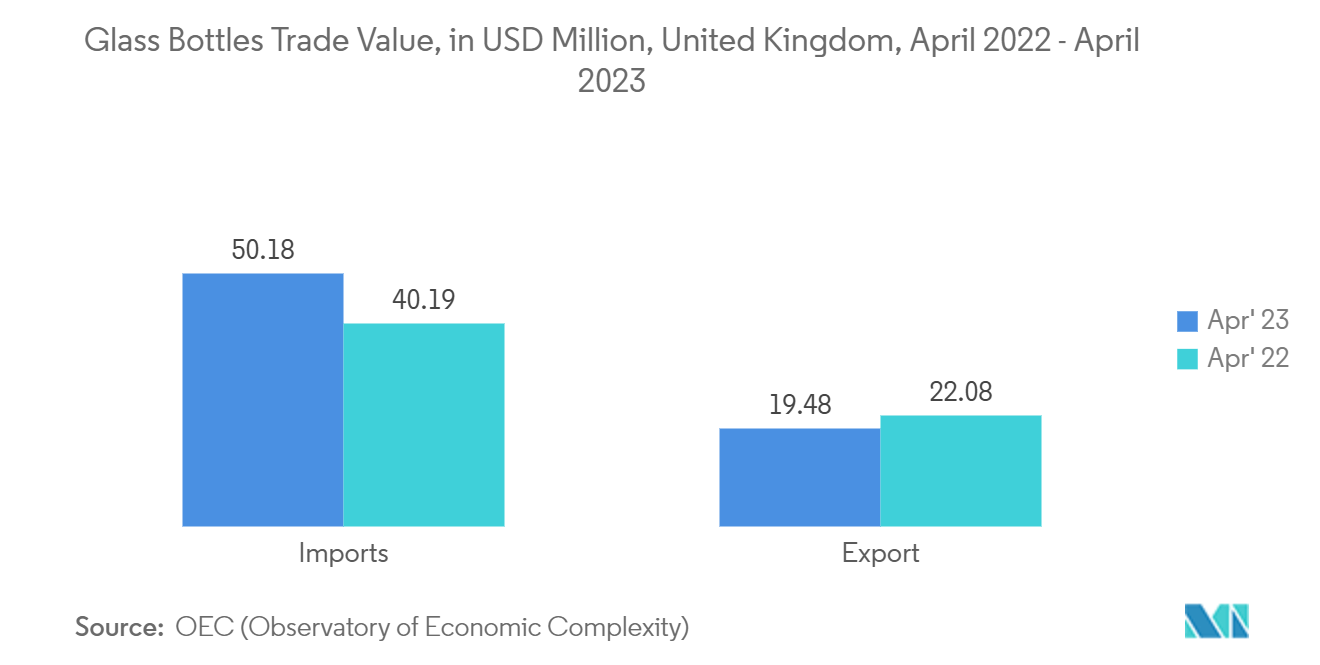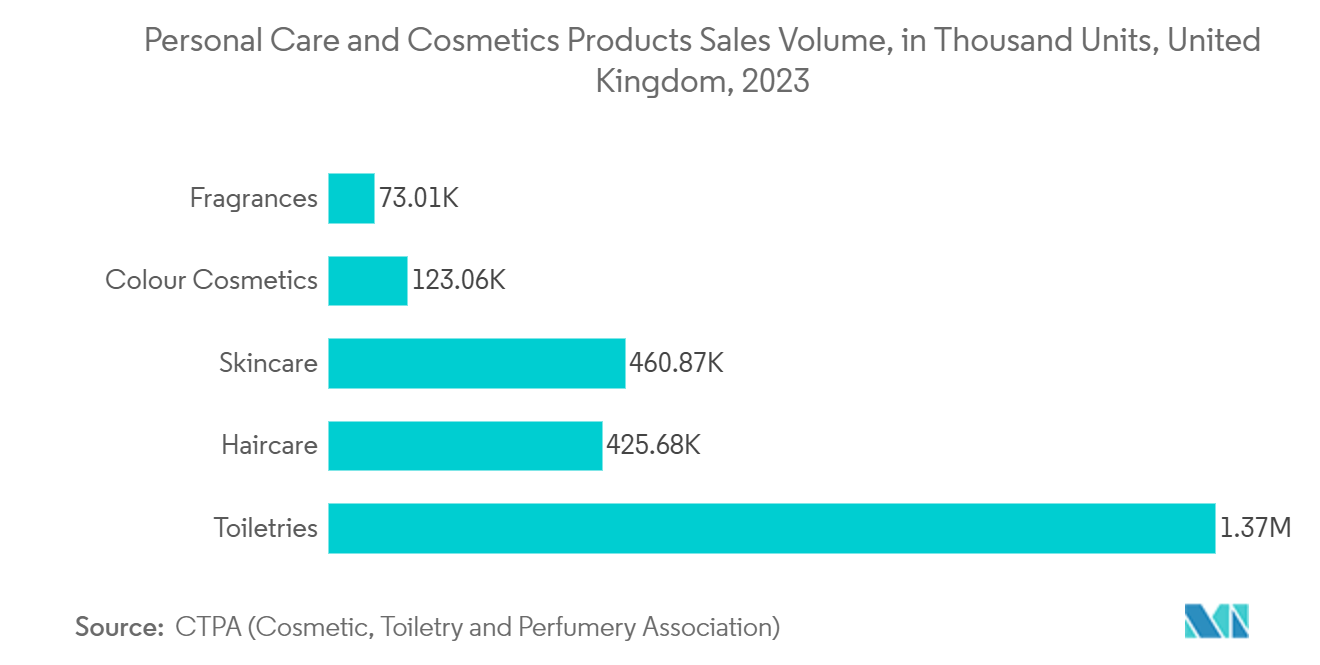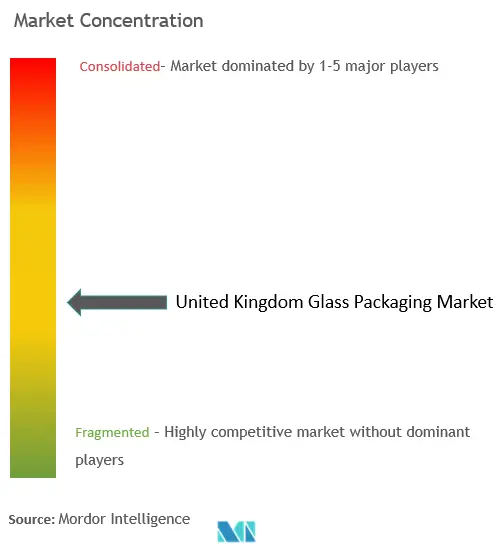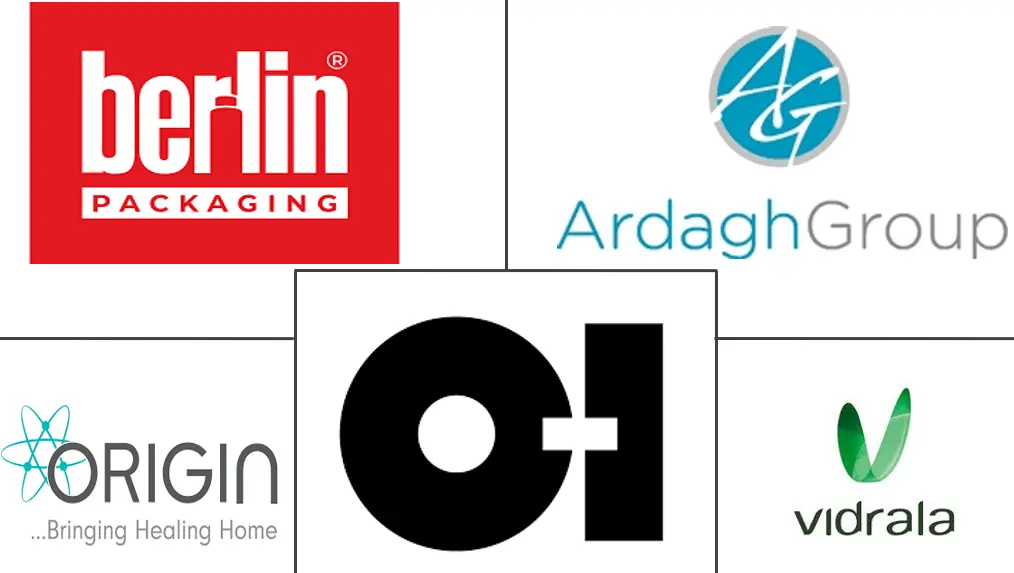
United Kingdom Glass Packaging Market Analysis by Mordor Intelligence
The United Kingdom Glass Packaging Market size is worth USD 3.31 Billion in 2025, growing at an 3.30% CAGR and is forecast to hit USD 3.89 Billion by 2030.
- Growing consumer demand for safer and healthier packaging is driving the expansion of glass packaging across various categories. Innovative technologies, such as embossing, shaping, and artistic finishes, are enhancing the appeal of glass packaging to end users. In addition, the surging demand for eco-friendly products, particularly from the food and beverage sector, is propelling market growth. As consumers increasingly gravitate toward beer and wine, glass packaging manufacturers are adapting their production accordingly. Premium food and beverage brands favor container glass over alternatives like plastic, citing glass's chemical inertness, non-porous nature, and impermeability.
- In recent years, the food packaging industry has witnessed a growing trend toward transparency. Glass containers house a diverse array of foods, from instant coffee and processed baby foods to dairy products and sugar preserves. Beyond just ingredients, consumers want to see the product physically before buying. To leverage this trend, many companies, especially in the dairy sector, are transitioning to transparent glass containers. The push for sustainable and eco-friendly packaging bolsters the glass packaging market. Research by Trivium Packaging highlights that about 74% of consumers are willing to pay a premium for sustainable packaging.
- The glass bottles and containers market in the country seeks a stable policy framework for decarbonization, enabling manufacturers to invest in reducing greenhouse gas emissions. In August 2023, the French government, in a move contrasting with the European Union, allocated GBP 171.6 million (USD 211.5 million) to destroy surplus wine and bolster producers. This initiative aims to stabilize prices, ensuring winemakers regain revenue sources. A similar trend termed the "bullwhip effect," is anticipated in the United Kingdom, potentially benefiting the studied market.
- In June 2024, Aegg unveiled its new spirit bottle, 'Gediz,' as part of its food and drink packaging lineup. Building on the success of the 'Yenice' spirit bottle, the Gediz boasts an eye-catching design with a spacious panel for printing or labeling, making it ideal for various spirit-based products.
- Anticipated fluctuations in energy prices are pushing businesses to secure long-term contracts to shield against volatile raw material and energy costs. This is especially crucial for those in the food and beverage sector, where sudden price shifts can drive consumers to rival brands. The UK wine industry, for example, is grappling with a glass shortage, leading to steep price increases for bottlers. Beyond these challenges, many UK bottlers have been stockpiling in anticipation of Brexit, and a notable shift from plastic to glass bottles by brand owners has further strained the market.
United Kingdom Glass Packaging Market Trends and Insights
Beverage Segment is Set to Witness The Highest Growth
- Glass bottles have long been a favored packaging choice in the beverage industry, a trend that remains steadfast today. They provide numerous advantages, such as preserving product quality and shielding contents from external factors.
- Due to their chemical sterility and non-permeability, glass bottles and containers are predominantly utilized for alcoholic and non-alcoholic beverages. Glass stands out as an excellent barrier material, boasting high transparency for packaging. Its properties ensure a prolonged shelf life by resisting CO2 loss and O2 intrusion. Recent advancements in processing and coatings have enhanced the frangibility of glass bottles, while modern lightweight techniques bolster their strength and user-friendliness.
- Data from the Observatory of Economic Complexity (OEC) reveals that in April 2023, the UK exported glass bottles worth GBP 15.8 million (USD 19.48 million) and imported them at GBP 40.7 million (USD 50.18 million), leading to a trade deficit of GBP 24.9 million (USD 30.70 million). Between April 2022 and April 2023, UK glass bottle exports dipped by GBP 931,000 (USD 1,147,965), marking a 5.57% decline from GBP 16.7 million (USD 20.59 million) to GBP 15.8 million (USD 19.48 million). In contrast, imports surged by GBP 10 million (USD 12,330,456.2), a notable 33.9% increase, rising from GBP 30.4 million (USD 37.48 million) to GBP 40.07 million (USD 49.40 million).
- The rising imports of glass bottles in the United Kingdom are primarily fueled by demand from alcoholic and non-alcoholic beverage sectors, a trend anticipated to persist in the coming years.
- Trends in premiumization have influenced the choice of glass packaging across various beverage segments, including soft drinks. Given their widespread appeal and diverse flavors tailored for every occasion, soft drinks command a substantial share of the market. Notably, data from UNESDA highlights that in several European markets, low-calorie and sugar-free beverages represent up to 30% of sales.

Cosmetic Sector is Expected to Witness Significant Share
- Glass packaging is the preferred choice for exclusive fragrances, skincare, and personal care products. The glass utilized in cosmetics and fragrances is primarily derived from natural and sustainable materials, including sand, limestone, and soda ash. Notably, glass packaging boasts a 100% recyclability rate, allowing it to be recycled infinitely without any degradation in quality or purity. Impressively, 80% of recycled glass is repurposed into new glass products.
- In the personal care industry, glass is synonymous with luxury. Its heft surpasses that of alternative packaging materials, and its higher cost fosters a perception of premium quality, thereby elevating the product's perceived value. Cosmetic packaging encompasses a range of containers, including bottles, jars, vials, and ampoules, catering to skincare, haircare, nail care, and makeup products. These cosmetic containers, especially in luxury segments, prominently feature glass. Glass jars and bottles are favored for their versatility, accommodating various dispensing options like jet and drop inserts, frothing caps, spray nozzles, and pump heads.
- As consumers become more conscious of their appearance and the need for sun and pollution protection, the cosmetics and perfume market is witnessing significant growth. Companies in this sector are heavily investing in innovations, aiming to sustain growth and introduce new, value-added products annually, particularly in mature categories. This trend piques consumer interest not only in preventive measures but also in treatments. Consequently, products like refreshing, detoxifying, and moisturizing solutions are poised for a surge in demand. Such dynamics are propelling the demand for glass bottles and containers in the personal care and cosmetics arena.
- Data from the Cosmetics, Toiletry, and Perfumery Association (CTPA) highlights a robust performance in the toiletries and beauty sectors for 2023, surpassing the previous year's metrics. The industry's total valuation experienced a Y-o-Y surge of 9.7%, reaching a notable GBP 9.56 billion (equivalent to USD 12.14 billion). With inflation rates stabilizing and an uptick in the frequency of beauty and toiletry usage, the industry is optimistic about even more pronounced growth in the forthcoming years, a trend likely to bolster the glass packaging market in the United Kingdom.

Competitive Landscape
The United Kingdom glass packaging market is moderately competitive, with many regional and global players such as Ardagh Packaging, Berlin Packaging, Owens-Illinois Inc., and many more. The companies are leveraging strategic collaborative initiatives to increase market share and profitability. However, the properties of glass and its benefits to beverages, cosmetics, and other industries are leading to the increased adoption of glass bottles and containers. Vendors are focusing on replacing plastic with environmentally friendly product glass.
• July 2024: United Kingdom-based glass packaging firm Croxsons completed one year of the unveiling of its new primary packaging solution for Necessary Good, a brand specializing in refillable skincare essentials. This innovative glass packaging was manufactured by Croxson's dedicated division focusing on lifestyle, beauty, health, and wellness. The manufacturer produced two cylindrical glass bottle sizes for Necessary Goods, which are 100 ml and 200 ml.
• May 2023: In the United Kingdom, Ardagh Glass Packaging (AGP) announced the construction of a sustainable 'Efficient Furnace' aimed at curbing greenhouse gas emissions during glass production. This furnace, set to be installed at AGP's Doncaster facility, leverages advanced industrial technology. The furnace is equipped with an advanced gas filtration system, utilizing innovative filter technology to address and significantly diminish other emission elements, achieving levels well below current industrial benchmarks. This ambitious project receives partial funding from the Government's Industrial Energy Transformation Fund (IETF), an initiative designed to assist energy-intensive businesses in their shift towards a low-carbon future.
United Kingdom Glass Packaging Industry Leaders
-
Ardagh Packaging Group PLC
-
Owens-illinois Inc
-
Origin Pharma Packaging
-
Vidrala SA
-
Berlin Packaging L.L.C
- *Disclaimer: Major Players sorted in no particular order

Recent Industry Developments
- June 2024: SINA Medical Glass revealed plans to transform a distribution warehouse into a manufacturing facility in St. Helens, United Kingdom. The facility aims to produce 300 million glass vials annually, adequately covering the United Kingdom's yearly demand of 150 to 200 million vials, with the surplus earmarked for export. In collaboration with Glass Futures, and as a member, SINA is anticipated to spearhead the development of a new furnace design, emphasizing sustainability in its medical glass products.
- May 2024: In collaboration with a leading discounter, Lanchester Wines became the first UK wine importer to introduce a super lightweight 300 g wine bottle. The Bordelaise Air, manufactured with approximately 30% recycled glass and tailored for the wine industry, seeks to uphold the traditional aesthetics of the classic Bordelaise/Bordeaux wine bottle.
United Kingdom Glass Packaging Market Report Scope
The scope of the study characterizes the glass packaging market based on the product type, including bottles, jars, vials, and others used across various end-user industries such as food, beverages, pharmaceuticals, cosmetics, toiletries, and more across the country. The research also examines underlying growth influencers and significant industry vendors, all of which help to support market estimates and growth rates throughout the anticipated period. The market estimates and projections are based on the base year factors and arrived at top-down and bottom-up approaches.
The United Kingdom glass packaging market is segmented by product type (bottles, vials, ampoules, jars, and other product types (pre-filled syringes, phials, and flacons, among others), and by end-use vertical (beverages [alcoholic (beer and cider, wine and spirit, and other alcoholic beverages)], non-alcoholic (carbonated soft drinks, milk, water, and other non-alcoholic beverages)], food, personal care and cosmetics, healthcare and pharmaceuticals, and other end-use vertical). The market sizes and forecasts are provided in terms of value (USD) for all the above segments.
| Bottles |
| Vials |
| Ampoules |
| Jars |
| Other Product Type (Pre-Filled Syringes, Phials, Flacons, among Others) |
| Beverages | Alcoholic** | Beer and Cider |
| Wine and Spirit | ||
| Other Alcoholic Beverages | ||
| Non-alcoholic** | Carbonated Soft Drinks | |
| Milk | ||
| Water and Other Non-alcoholic Beverages (Juices, Among others) | ||
| Food | ||
| Personal Care and Cosmetics | ||
| Healthcare and Pharmaceutical | ||
| Other End-use Verticals | ||
| By Product Type | Bottles | ||
| Vials | |||
| Ampoules | |||
| Jars | |||
| Other Product Type (Pre-Filled Syringes, Phials, Flacons, among Others) | |||
| By End-use Vertical | Beverages | Alcoholic** | Beer and Cider |
| Wine and Spirit | |||
| Other Alcoholic Beverages | |||
| Non-alcoholic** | Carbonated Soft Drinks | ||
| Milk | |||
| Water and Other Non-alcoholic Beverages (Juices, Among others) | |||
| Food | |||
| Personal Care and Cosmetics | |||
| Healthcare and Pharmaceutical | |||
| Other End-use Verticals | |||
Key Questions Answered in the Report
How big is the United Kingdom Glass Packaging Market?
The United Kingdom Glass Packaging Market size is worth USD 3.31 billion in 2025, growing at an 3.30% CAGR and is forecast to hit USD 3.89 billion by 2030.
What is the current United Kingdom Glass Packaging Market size?
In 2025, the United Kingdom Glass Packaging Market size is expected to reach USD 3.31 billion.
Who are the key players in United Kingdom Glass Packaging Market?
Ardagh Packaging Group PLC, Owens-illinois Inc, Origin Pharma Packaging, Vidrala SA and Berlin Packaging L.L.C are the major companies operating in the United Kingdom Glass Packaging Market.
What years does this United Kingdom Glass Packaging Market cover, and what was the market size in 2024?
In 2024, the United Kingdom Glass Packaging Market size was estimated at USD 3.20 billion. The report covers the United Kingdom Glass Packaging Market historical market size for years: 2019, 2020, 2021, 2022, 2023 and 2024. The report also forecasts the United Kingdom Glass Packaging Market size for years: 2025, 2026, 2027, 2028, 2029 and 2030.
Page last updated on:
United Kingdom Glass Packaging Market Report
Statistics for the 2025 United Kingdom Glass Packaging market share, size and revenue growth rate, created by Mordor Intelligence™ Industry Reports. United Kingdom Glass Packaging analysis includes a market forecast outlook for 2025 to 2030 and historical overview. Get a sample of this industry analysis as a free report PDF download.



